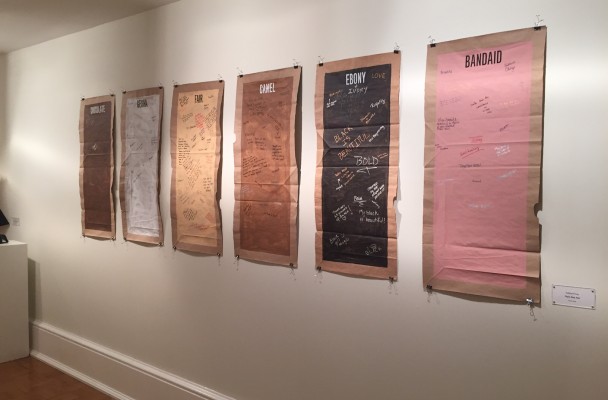‘Art + Dialogue’ at Sechrest turns racial issues tangible

“Paper Bag Test” by IlaSahai Proutty. Photos by: Liz Reichart
By Liz Reichart // A&E Editor
Racially charged movements have been breathed new life in recent years, not willing for their ideas to be denied voice and volume. Movements like “Black Lives Matter” have left many to wonder whether or not we are participating in a new civil rights movement on many fronts. “Art + Dialogue: Responding to Racial Tension in America,” is a new visual art exhibition on display in the Sechrest Gallery through March 3. The aim of the collaborative project is to start discussion on the charged topic of race issues in America and make this conversation a more tangible one.
Maxine Campbell, curator of the Sechrest Gallery, explained that the seed for this project was planted at a meeting with Laura Way, CEO and Executive Director of the Greenhill Center for North Carolina Art.
“The Greenhill initiated this collaborative project intended to bring community together using visual art as the catalyst for dialogues around racial tension in America,” Campbell said.
From there, the effort was entirely a combined one. The Greenhill partnered with the African American Atelier, Center for Visual Artists and the Guilford Native American Art Gallery. These organizations all worked together to execute a call for North Carolina artists to exhibit work dealing with predefined themes that set the framework for dialogue responses to the topic of racial tension.
The result was an original exhibition at Greensboro College in September 2015. “Art + Dialogue” is a selection of work from this exhibit by the Sechrest Gallery Exhibition Committee.
“We also augmented with meaningful work by other local artists,” Campbell said. “We chose to additionally create gallery specific interactive installation pieces conceived and made by Trevor Berreth, our recently hired Gallery Assistant.”
Berreth, a North Carolina multimedia and graphical artist, tells viewers that the importance of this exhibit in modern era cannot be overstated.
“When you look at the streets, really look at what our neighborhoods look like,” Berreth said, “how different does it look from the Jim Crow era? There is class segregation, there is homogeneity based on location and there is a blind eye turned toward the rights of minorities especially, when the cry for social reform is screaming the loudest. The fact that racial tension is an issue points to a societal and cultural problem that has never been mended. The scars of the past remind us here in the present of what injustice looks like, yet new wounds are opened on top of those scars and there doesn’t seem to be an end to racism in America.”
Unlike the stoic unmoving environment of a typical gallery, “Art + Dialogue” is full of life. Viewers are engaged in a conversation through interactive displays and dialogue sessions. Berreths’ hands-on pieces include “Web of Tension” where gallery goers tie colored strings around plywood pegs at different heights to rate how true statements like “I feel that social equality is an unachievable ideal” are to them. The result? A visual masterpiece of taut color that sparks immediate debate.
IllaSahai Prouty’s “The Paper Bag Test” gives visitors a permanent marker and invites them to write the first thought that comes to mind on the bags to describe each respective bags’ color label. Colors of bags include ebony, fair, geisha, chocolate and more. Sechrest viewers have written everything on these alternative canvasses from “black is beautiful” to “created by the people who resent it” to “togetherness.” A massive plywood chalkboard with jutting panels takes up the center of the exhibit. This is Berreth’s “Compelled to Speak Freely.” It invites viewers to write down their thoughts or favorite quotations. In short, speak freely.
“This exhibit does two things,” Berreth said. “It juxtaposes old scars to new wounds to show us the similarities and it opens the gallery up as a public forum for discussion. This is now a place for people to go and express their feelings and scratch their itch to be heard. We are exhibiting ideas as art and opinions as reflections of the soul and conscience of our community.”
The gallery is located in Hayworth Fine Arts and is open Monday through Thursday from 1-5 P.M. If you are interested in learning more or have further questions, please contact Berreth at tberreth@highpoint.edu.